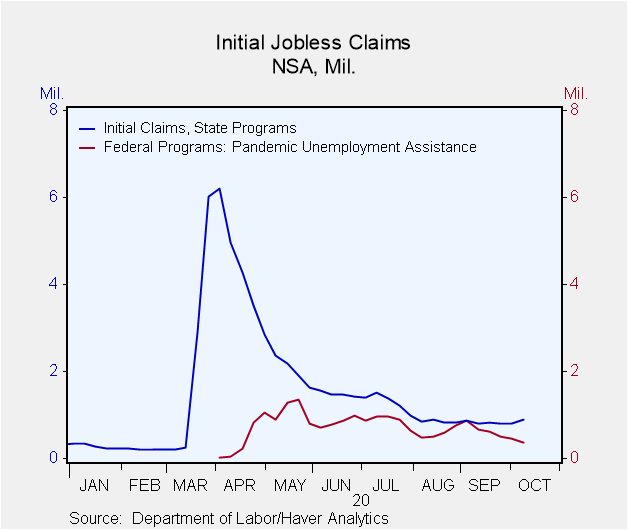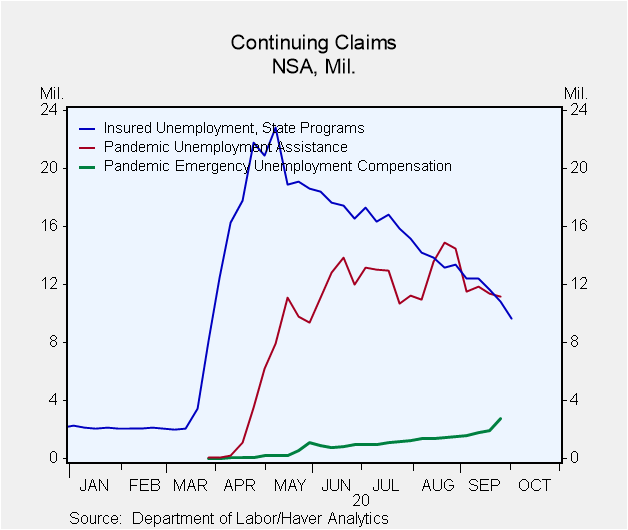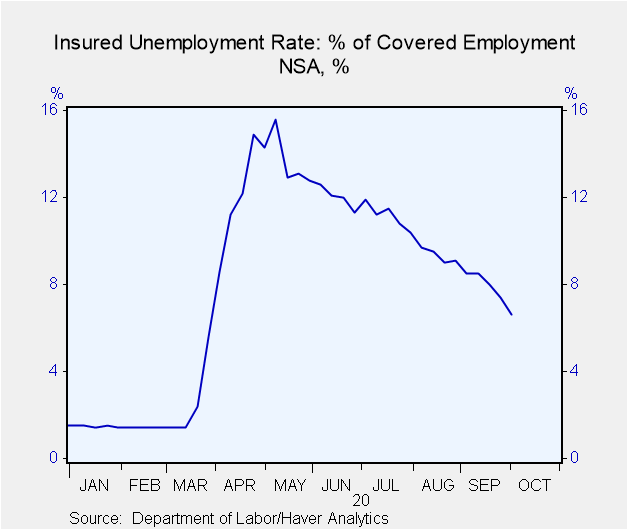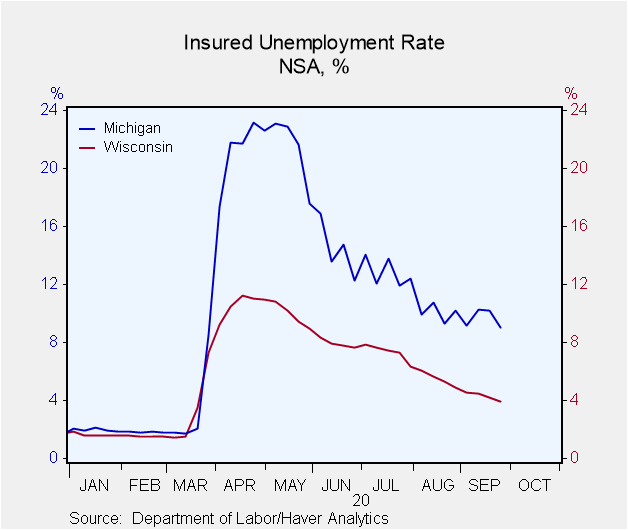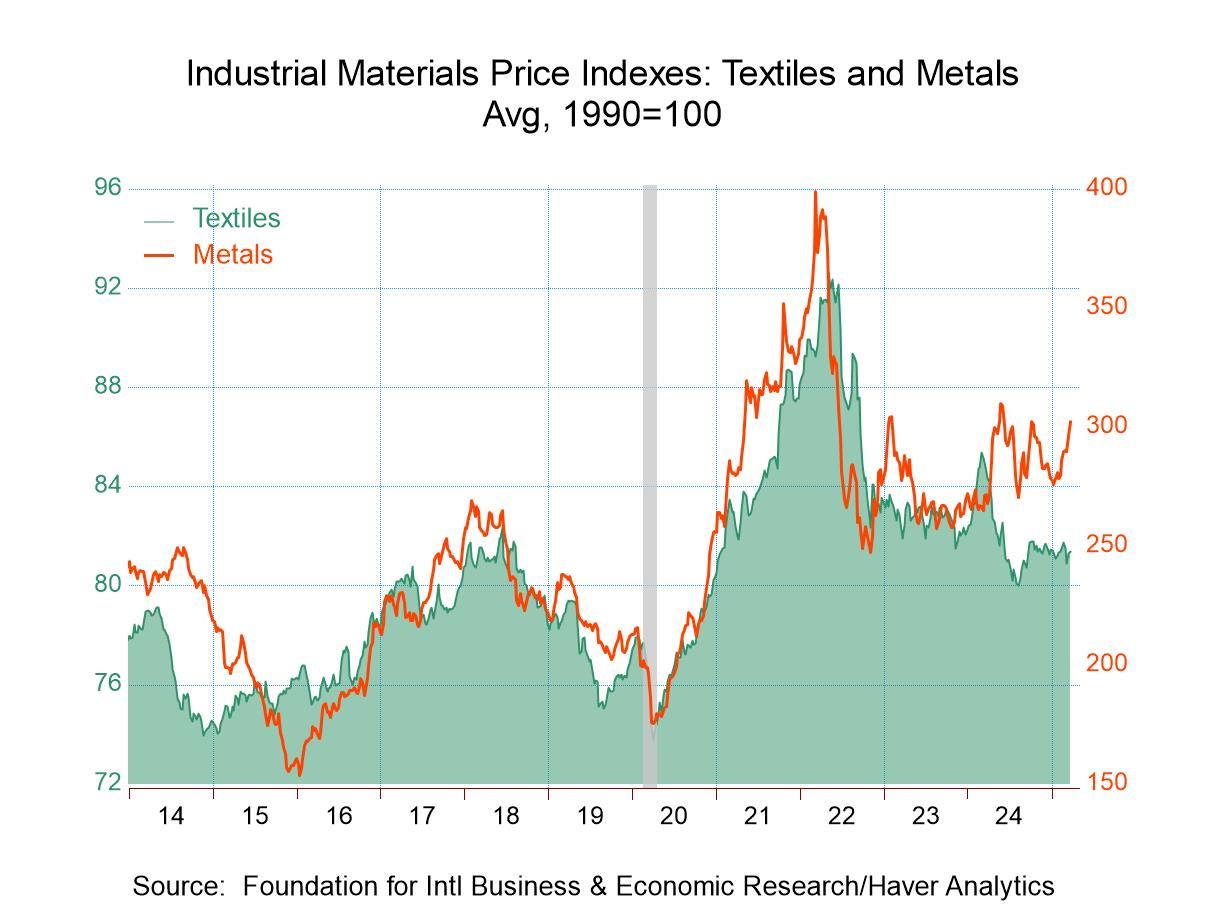 Global| Oct 15 2020
Global| Oct 15 2020U.S. Mixed Jobless Claims Data; California Still on Hold
Summary
• State initial claims rose to highest level since mid-August on both a seasonally adjusted and not seasonally adjusted basis. • Federal Pandemic Unemployment Assistance new filers decreased for fifth consecutive week to lowest level [...]
• State initial claims rose to highest level since mid-August on both a seasonally adjusted and not seasonally adjusted basis.
• Federal Pandemic Unemployment Assistance new filers decreased for fifth consecutive week to lowest level since mid-April.
• State and PUA continuing claims declined while PEUC continued upward march.
• California data remains in holding pattern using mid-September data, making all this data subject to potential significant revisions.
Seasonally adjusted state initial jobless claims for unemployment insurance rose to 898,000 in the week ending October 10 from 845,000 in the previous week. This is the highest level of claims since August 22. The Action Economics Forecast Survey anticipated 828,000. A change in the calculation of seasonal adjustment factors created a break in the series in late August. Though the current week-to-week comparison is valid, the comparison to August 22 is not. For more details, please see the September 3 commentary on jobless claims.
The not seasonally adjusted data, which is comparable across all periods for initial claims jumped to 885,885 in the week ending October 10 from 809,215. Haver Analytics has calculated methodologically consistent seasonally adjusted data. This shows claims increasing to 899,000 from 845,000. Both series are at their highest level since August 15. As this data illustrates, our calculated seasonal adjustment factors very closely match the Department of Labor seasonals.
Claims for the federal Pandemic Unemployment Assistance (PUA) program, which covers individuals such as the self-employed who are not qualified for regular/state unemployment insurance, decreased for the fifth consecutive week to 372,891. This is the lowest level since mid-April. Numbers for this and other federal programs are not seasonally adjusted.
Seasonally adjusted state continuing claims for unemployment insurance fell to 10.018 million in the week ending October 3, from 11.183 million. Haver Analytics methodologically consistent seasonally adjusted continuing claims showed the same readings for those weeks and finds the October 3 number is the lowest level of continuing claims since late March. Not seasonally adjusted continuing claims dropped to 9.632 from 10.820 million, also the lowest since late March.
Continuing PUA claims, which are lagged an additional week and not seasonally adjusted, declined to 11.172 million from 11.395 million. These statistics have been range-bound since late July. Meanwhile, Pandemic Emergency Unemployment Compensation claims continued their upward climb to a new high of 2.778 million in the week ending September 26. This program covers people who were unemployed before COVID but exhausted their state benefits and are now eligible to receive an additional 13 weeks of unemployment insurance, up to a total of 39 weeks.
The seasonally adjusted state insured rate of unemployment fell to 6.8% in the week ending October 3 from 7.7%. The not-seasonally-adjusted data dropped to 6.6% from 7.4%, the lowest since late March. This data does not include the federal pandemic assistance programs. If you include the latest data available, which is lagged one additional week, the total number of state, PUA and PEUC continuing claims declined to 23.6 million or 14.7% of the labor force. This is the lowest since early May.
The state insured rates of unemployment -- which do not include federal programs -- continued to show wide variation with South Dakota at just 1.2% and Hawaii at 17.9%. Six states had rates above 10% including New York and California. The largest states ranged between 3.9% for Florida and 16.1% for California. The state rates are not seasonally adjusted.
Note: In early October, California announced a two week pause in its processing of claims to reduce its claims processing backlog and implement fraud prevention technology. That pause has lasted longer than two weeks; thus, initial claims data from September 19 and continuing claims data from September 12 continue to be repeated in until completion of the pause. As a result, the last three-to-four weeks of data for both California and the U.S. could be meaningfully revised (California represents roughly 20% of all claims data though more recently has been an even higher share).
Data on weekly unemployment claims going back to 1967 are contained in Haver's WEEKLY database, and they are summarized monthly in USECON. Data for individual states are in REGIONW. The expectations figure is from the Action Economics Forecast Survey, carried in the AS1REPNA database.
| Unemployment Insurance (SA, 000s) | 10/10/20 | 10/03/20 | 09/26/20 | Y/Y % | 2019 | 2018 | 2017 |
|---|---|---|---|---|---|---|---|
| Initial Claims | 898 | 845 | 849 | 312 | 218 | 221 | 244 |
| Initial Claims (NSA) | 886 | 809 | 799 | 339 | 218 | 221 | 243 |
| Initial Claims Pandemic Unemployment Assistance (NSA) | 373 | 464 | 509 | -- | -- | -- | -- |
| Continuing Claims | -- | 10,018 | 11,183 | 493 | 1,701 | 1,756 | 1,961 |
| Continuing Claims (NSA) | -- | 9,632 | 10,820 | 603 | 1,704 | 1,763 | 1,964 |
| Continuing Claims Pandemic Unemployment Assistance (NSA) | -- | -- | 11,172 | -- | -- | -- | -- |
| Insured Unemployment Rate (%) | -- | 6.8 | 7.7 |
1.2 |
1.2 | 1.2 | 1.4 |
Gerald D. Cohen
AuthorMore in Author Profile »Gerald Cohen provides strategic vision and leadership of the translational economic research and policy initiatives at the Kenan Institute of Private Enterprise.
He has worked in both the public and private sectors focusing on the intersection between financial markets and economic fundamentals. He was a Senior Economist at Haver Analytics from January 2019 to February 2021. During the Obama Administration Gerald was Deputy Assistant Secretary for Macroeconomic Analysis at the U.S. Department of Treasury where he helped formulate and evaluate the impact of policy proposals on the U.S. economy. Prior to Treasury, he co-managed a global macro fund at Ziff Brothers Investments.
Gerald holds a bachelor’s of science from the Massachusetts Institute of Technology and a Ph.D. in Economics from Harvard University and is a contributing author to 30-Second Money as well as a co-author of Political Cycles and the Macroeconomy.


